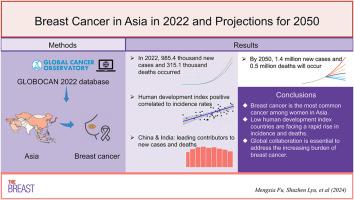Current and future burden of breast cancer in Asia: A GLOBOCAN data analysis for 2022 and 2050
IF 5.7
2区 医学
Q1 OBSTETRICS & GYNECOLOGY
引用次数: 0
Abstract
Background
Breast cancer remains a significant health concern in Asia. This study seeks to analyze the burden of breast cancer in Asia based on the most recent GLOBOCAN 2022 estimates.
Methods
Data were obtained from GLOBOCAN 2022. Age-standardized rates for incidence and mortality per 100,000 person-years were calculated using direct age standardization with the Segi-Doll World standard population. Pearson's correlation coefficient was utilized to evaluate the relationship between human development index and incidence or mortality rate. The future number of breast cancer cases and deaths by 2050 was estimated based on global demographic projections.
Results
In 2022, breast cancer accounted for 2296.8 thousand new cases and 666.1 thousand deaths worldwide. In Asia, an estimated 985.4 thousand new cases and 315.1 thousand deaths were reported, corresponding to age-standardized incidence and mortality rates of 34.3 and 10.5 per 100,000, respectively. Both incidence and mortality rates were notably higher among older individuals, especially in countries with high human development index. A positive correlation between human development index and incidence rates was observed, while mortality rates were highest in countries with low human development index. China and India are the leading contributors to both new cases and deaths, with projections indicating that by 2050, around 1.4 million new breast cancer cases and 0.5 million deaths are expected to occur in Asia.
Conclusion
Breast cancer is the most common cancer among women in Asia. Global collaboration is essential to reduce its growing burden, especially in low-HDI countries facing rising incidence and high mortality rates.

亚洲目前和未来的乳腺癌负担:2022 年和 2050 年 GLOBOCAN 数据分析。
背景:在亚洲,乳腺癌仍然是一个重大的健康问题。本研究旨在根据最新的 GLOBOCAN 2022 估计数据分析亚洲的乳腺癌负担:方法:数据来自 GLOBOCAN 2022。方法:数据来自 GLOBOCAN 2022,采用 Segi-Doll 世界标准人口的直接年龄标准化方法,计算出每 10 万人年的年龄标准化发病率和死亡率。皮尔逊相关系数用于评估人类发展指数与发病率或死亡率之间的关系。根据全球人口预测,估算了到 2050 年乳腺癌病例和死亡人数:结果:2022 年,全球新增乳腺癌病例 229.68 万例,死亡 66.61 万例。在亚洲,估计有 985,400 例新发病例和 315,100 例死亡病例,对应的年龄标准化发病率和死亡率分别为每 100,000 人 34.3 例和 10.5 例。老年人的发病率和死亡率都明显较高,尤其是在人类发展指数较高的国家。人类发展指数与发病率呈正相关,而人类发展指数低的国家死亡率最高。预计到 2050 年,亚洲将新增约 140 万乳腺癌病例和 50 万死亡病例:结论:乳腺癌是亚洲妇女最常见的癌症。结论:乳腺癌是亚洲妇女最常见的癌症,全球合作对减轻其日益沉重的负担至关重要,尤其是在发病率和死亡率不断上升的低人类发展指数国家。
本文章由计算机程序翻译,如有差异,请以英文原文为准。
求助全文
约1分钟内获得全文
求助全文
来源期刊

Breast
医学-妇产科学
CiteScore
8.70
自引率
2.60%
发文量
165
审稿时长
59 days
期刊介绍:
The Breast is an international, multidisciplinary journal for researchers and clinicians, which focuses on translational and clinical research for the advancement of breast cancer prevention, diagnosis and treatment of all stages.
 求助内容:
求助内容: 应助结果提醒方式:
应助结果提醒方式:


